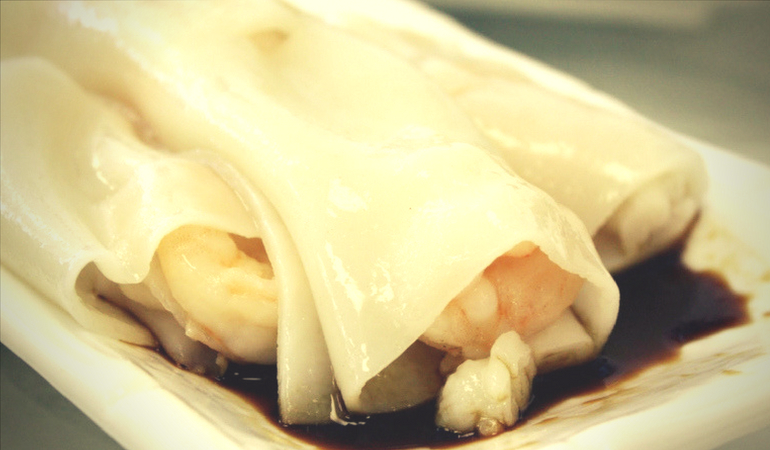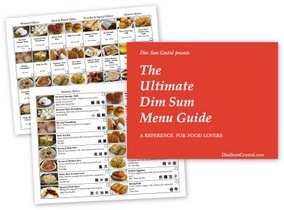This recipe is part of our collection of Noodles & Special Dim Sum Dishes. Sign up for our newsletter to get recipes, dining tips and restaurant reviews throughout the year!
Noodle rolls are formed from a long rice noodle sheet that is then wrapped around a filling of barbecued pork, beef, shrimp, scallions or a Chinese donut and served with soy sauce. A dim sum favorite, noodle rolls are also served as part of a simple breakfast alongside a cup of hot tea.
At a restaurant, the rice noodle mixture and filling are combined on a steam-permeable cloth and cooked in large commercial steamers. The noodles are then finished with the addition of a warm, sweetened soy sauce as they are unveiled at your table.
At home, it’s best to work from packaged rice noodle rolls, as the delicate wrappers are difficult to make properly without the restaurant apparatus. Your rolls will vary in smoothness with the quality of the noodle you select, but a well-made filling will still result in a savory, aromatic final product.
Can you share any expert tips from your experience making shrimp noodle rolls? Want to ask a question before you try making it yourself? I’d love to hear from you in the comments section below!
Shrimp Noodle Rolls Recipe
Makes: 4 Rolls | Prep Time: 15 Minutes | Cook Time: 15 Minutes
Adapted From: The Food of China: A Journey for Food Lovers
Ingredients
9 ounces shrimp
1 tablespoon oil
3 green onions, chopped
2 tablespoons cilantro, chopped
4 fresh rice noodle rolls
Directions
1. Peel and devein the shrimp. Heat a wok over high heat, add the oil and heat until very hot. Stir fry the shrimp for 1 minute until pink and cooked through. Season with salt and pepper, add the green onion and cilantro and mix well. Set aside.
2. Carefully unroll the rice noodle rolls. Trim each in a rectangle approximately 6 inches by 7 inches. Divide the filling among the rolls, then re-roll the noodles.
3. Put the rolls on a plate in a large bamboo steamer, cover and steam for 5 minutes. Serve the rolls cut into pieces and drizzled with light soy sauce or oyster sauce.
Learn more about Shrimp Noodle Rolls from these Experts
Watch the chefs at O’Asian Kitchen make rice noodle rolls (VIDEO)
The Woks of Life make homemade rice noodle rolls
SF Dim Sum Cart shares their recipe for rice noodle rolls
HT: Photo by Sherman’s Food Adventures.





Saundra Holland-Neal
I now live in rural Northern New York, after living in San Francisco for 20 years. Now that I’m no where near Asian markets anymore, is there an online market to buy rice noodle rolls? I can find eggroll wrappers, etc here. Thanks!
Dim Sum Central
Hi Saundra, I’m afraid I don’t have an easy solution for you. The rice noodles need to be fresh and moist, so they don’t really tolerate storage and shipping well. Perhaps you could try this rice roll paper, commonly used in Thai spring rolls, as a reasonable approximation: https://www.asianfoodgrocer.com/asian-food/grocery/dried-products/spring-roll-skins. ~Wes
D.Chin
I’m not sure why this site has suggested using premade noodles. It’s really easy to make these but you will need some special tools. I have a deep hotel pan that I place over two burners. I fill the pan about 1/4th full with hot water. I then put in a perforated hotel pan insert. This is basically a rectangular pan that fits inside the hotel pan but it’s perforated with holes. The perforated insert pan sits above the water and once the water is boiling you add a lid and you now have a large steamer.
I then put a greased 13″ x 9″ x 2″ pan inside the perforated pan. The smaller pan will hold the rice noodle.
The rice noodle is easily made. I like using a mixture of 1 part tapioca starch to 4 parts glutinous rice flour. I add some salt and enough water to make a slightly thin batter. If your batter resembles a pancake batter, it’s too thick. It needs to be more loose like a crepe batter.
I pour just enough batter into the greased pan to cover the bottom. To help spread the batter out, I tilt the pan up and down and left and right so that the bottom of the pan is covered with a really thin coat of batter.
After bringing the water in the hotel pan to a rolling boil over high heat (both burners), I cover the hotel pan with a lid and steam the rice noodle pan for about 2 minutes. I then spoon just a bit of extra batter along one end of the noodle and then add 2 rows of shrimp. The batter will cook and hold the shrimp in place. NOTE: I did not do this at the outset because I didn’t want the shrimp falling through the batter.
I top the shrimp with fresh minced ginger and chopped onions. I steam this for another 2-3 minutes. I then add some chopped kale and Chinese cabbage or bok choy. I drizzle a small amount of oyster sauce over the vegetables and shrimp. Since oyster sauce tends to be as thick as ketchup, I actually dilute it with just a bit of water to make it more easy to pour. I then steam the mixture for another 1-2 minutes.
After removing the noodle pan from the steamer, I use a knife to cut it in half. I cut it right up the center from the bottom to the top. This will make it much easier to roll up. I use an offset spatula to loosen one side and then with a flip of the wrist, I start rolling it up.
The first roll usually scatters some vegetables, so I simply push them back in place and continue rolling until I reach the end of the pan. The cheong-fan is then transferred to a plate or a serving platter and I repeat the same rolling process with the other side. After garnishing the plate with chopped green onions, I have two servings of cheong-fan.
I would not recommend trying to make this using spring roll wrappers. Spring rolls are much too small and the texture is all wrong. Spring rolls also don’t have a high enough gluten content, so they’re much more likely to tear. This is why I use tapioca starch. The tapioca adds extra gluten and gives the noodle some added texture.
Wes – I hope I wasn’t intrusive by adding this comment. I’m the chef instructor of a Culinary Arts program and thought I’d add my two cents worth to what I think is a really great website.
Regards,
Chef David Chin, M.Ed.
Dim Sum Central
Chef David, thank you so much for adding this tutorial. Can’t wait to try your technique myself! ~Wes
Zenaida chua maghirang
How can I make rice noddle? I’m from Reno,we do have Asian store here.
Dim Sum Central
Hi Zenaida, if you’re able to visit an Asian market with fresh noodles, they may carry the thin white noodle sheets you’ll need to make various kinds of cheung fun. That would be the easiest path! ~Wes